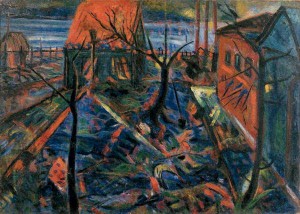In discussing the roots of the polyphonic novel in his book Problems of Dostoyevsky’s Work, which came out in 1929, Mikhail Bakhtin speaks about a genre he calls “experimental fantasy” and mentions Varron’s “Endymion,” which describes the life of a city as being watched from above.
Taking a new point of view on the surrounding world and inability to see and accept reality the way one did before is something running through Alexander Labas’s works mentioned above, but it takes a somewhat different, grotesque turn in Yefrosiniva Yermilova-Platova’s painting “Kamenka. View from Above.” It shows something as seen not by a pilot or an aeroplane passenger but by somebody or something unknown that hovers over a small village, over the bank of a river, and over an island. This piece of landscape opens up to and builds a link with the “somebody” who is above and acquires an additional, unearthly dimension creating an unexpected vector of movement, movement “from here,” and blowing up the habitual routine of daily life.
The world is seen in an even more fantastic and completely different way By Boris Golopolosov, one of the most vivid and outstanding young artists of the twenties and a member of the Painters Guild association.
In the twenties, in a situation where cultural life was undergoing sweeping reconstruction, he was portraying a world compressed to the size of personal psychoses, phobias and maniacal conditions. It is a disastrous world. People inhabiting it are mad and suicidal, and no one else would be able to live there. In 1923-1924, the artist created a series of works that included “Crucified”, “Solitude. The Murderer,” “Lunatic,” and “Flood.” “Flood,” the peak of the series, is an emotional upsurge that drowns and destroys stable reality. The artist becomes aware of the absolute impossibility to live and of a cultural collapse, and cannot explain what is happening around him or what has happened to him, everything gets melted down and disappears in a single stream, and there is no personal or social history. There is only a catastrophe and art — as attempt to stay human.
One could attribute those paintings to the artist’s young age and propensity for dramatic effects if one didn’t know that later on, in 1937, Boris Golopolosov, a violin player and the son of an old revolutionary who left the Bolshevik Party in 1925, made one of the most poignant and shocking paintings in Russian art history, “Man Beating His Head Against the Wall.” While working on it, he went back to watercolors and sketches of nearly 15 years before. A year later he created the grim and oppressive “Blind Alley,” after which he abandoned art for decades.



